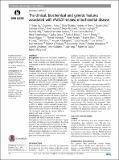The clinical, biochemical and genetic features associated with RMND1-related mitochondrial disease

View/
Author
Ng, Yi Shiau
Alston, Charlotte L
Diodato, Daria
Morris, Andrew A
Ulrick, Nicole
Kmoch, Stanislav
Houštěk, Josef
Martinelli, Diego
Atiq, Mehnaz
Gamero, Montserrat Anton
Garcia-Martinez, Elena
Kratochvílová, Hana
Santra, Saikat
Brown, Ruth M
Brown, Garry K
Ragge, Nicola
Monavari, Ahmad
Pysden, Karen
Ravn, Kirstine
Casey, Jillian P
Khan, Arif
Chakrapani, Anupam
Vassallo, Grace
Simons, Cas
McKeever, Karl
O'Sullivan, Siobhan
Childs, Anne-Marie
Østergaard, Elsebet
Vanderver, Adeline
Goldstein, Amy
Vogt, Julie
Taylor, Robert W
McFarland, Robert
Note: Order does not necessarily reflect citation order of authors.
Published Version
https://doi.org/10.1136/jmedgenet-2016-103910Metadata
Show full item recordCitation
Ng, Y. S., C. L. Alston, D. Diodato, A. A. Morris, N. Ulrick, S. Kmoch, J. Houštěk, et al. 2016. “The clinical, biochemical and genetic features associated with RMND1-related mitochondrial disease.” Journal of Medical Genetics 53 (11): 768-775. doi:10.1136/jmedgenet-2016-103910. http://dx.doi.org/10.1136/jmedgenet-2016-103910.Abstract
Background: Mutations in the RMND1 (Required for Meiotic Nuclear Division protein 1) gene have recently been linked to infantile onset mitochondrial disease characterised by multiple mitochondrial respiratory chain defects. Methods: We summarised the clinical, biochemical and molecular genetic investigation of an international cohort of affected individuals with RMND1 mutations. In addition, we reviewed all the previously published cases to determine the genotype–phenotype correlates and performed survival analysis to identify prognostic factors. Results: We identified 14 new cases from 11 pedigrees that harbour recessive RMND1 mutations, including 6 novel variants: c.533C>A, p.(Thr178Lys); c.565C>T, p.(Gln189*); c.631G>A, p.(Val211Met); c.1303C>T, p.(Leu435Phe); c.830+1G>A and c.1317+1G>T. Together with all previously published cases (n=32), we show that congenital sensorineural deafness, hypotonia, developmental delay and lactic acidaemia are common clinical manifestations with disease onset under 2 years. Renal involvement is more prevalent than seizures (66% vs 44%). In addition, median survival time was longer in patients with renal involvement compared with those without renal disease (6 years vs 8 months, p=0.009). The neurological phenotype also appears milder in patients with renal involvement. Conclusions: The clinical phenotypes and prognosis associated with RMND1 mutations are more heterogeneous than that were initially described. Regular monitoring of kidney function is imperative in the clinical practice in light of nephropathy being present in over 60% of cases. Furthermore, renal replacement therapy should be considered particularly in those patients with mild neurological manifestation as shown in our study that four recipients of kidney transplant demonstrate good clinical outcome to date.Other Sources
http://www.ncbi.nlm.nih.gov/pmc/articles/PMC5264221/pdf/Terms of Use
This article is made available under the terms and conditions applicable to Other Posted Material, as set forth at http://nrs.harvard.edu/urn-3:HUL.InstRepos:dash.current.terms-of-use#LAACitable link to this page
http://nrs.harvard.edu/urn-3:HUL.InstRepos:31731796
Collections
- HMS Scholarly Articles [17922]
Contact administrator regarding this item (to report mistakes or request changes)


